Related Research Articles
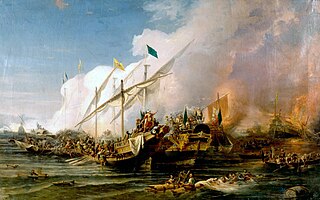
The Battle of Preveza was a naval engagement that took place on 28 September 1538 near Preveza in the Ionian Sea in northwestern Greece between an Ottoman fleet and that of a Holy League. The battle was an Ottoman victory which occurred in the same area in the Ionian Sea as the Battle of Actium in 31 BC. It was one of the three largest sea battles that took place in the sixteenth century Mediterranean, along with the Battle of Djerba and the Battle of Lepanto.

The Battle of Modon, aka the Second Battle of Lepanto, took place in August 1500 during the war of 1499–1503 between the Ottoman Empire and the Republic of Venice. The Ottomans, who had won the Battle of Zonchio the previous year, were again victorious under Admiral Kemal Reis.
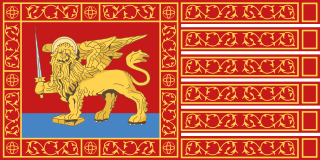
The Republic of Venice or Venetian Republic, traditionally known as La Serenissima, was a sovereign state and maritime republic with its capital in Venice. Founded, according to tradition, in 697 by Paolo Lucio Anafesto, over the course of its 1,100 years of history it established itself as one of the major European commercial and naval powers. Initially extended in the Dogado area, during its history it annexed a large part of Northeast Italy, Istria, Dalmatia, the coasts of present-day Montenegro and Albania as well as numerous islands in the Adriatic and eastern Ionian seas. At the height of its expansion, between the 13th and 16th centuries, it also governed the Peloponnese, Crete and Cyprus, most of the Greek islands, as well as several cities and ports in the eastern Mediterranean.

The Battle of Focchies was a significant naval engagement that took place on 12 May 1649, in the harbour of Focchies, Smyrna between a Venetian force of nineteen warships under the command of Giacomo da Riva, and an Ottoman force of eleven warships, ten galleasses, and seventy-two galleys, with the battle resulting in a crushing victory for the Venetian fleet. The battle was an episode in the Cretan War from 1645 to 1669 between the Venetian Republic and the Ottoman Empire over dominance of various territories in the Mediterranean Sea. The war was one in a series of wars between the two warring powers, which contested for control of the Adriatic and Mediterranean trade routes. The primary territory that was contested during the war was Crete, the largest and most profitable of the overseas holdings of the Venetian Republic. The battle came after a squadron of Venetian ships under the command of Giacomo da Riva, a Venetian admiral, came to the rescue of the blockading Venetian force in the Dardanelles Straits, after the blockade had run into unexpected weather conditions and many ships sunk as a result.
The Battle of Andros took place on 22 August 1696 southeast of the Greek island of Andros between the fleets of the Republic of Venice and the Papal States under Bartolomeo Contarini on the one side and the Ottoman Navy, under Mezzo Morto Hüseyin Pasha, and allied Barbary forces on the other. The encounter was indecisive, and no vessels were lost on either side.
The Battle of Mytilene was a naval battle that occurred on 8 September 1690 at Mytilene between a Venetian fleet under Daniele Dolfin and a combined Muslim fleet made up of Ottoman and Barbary ships. The battle resulted in a victory for the Venetian naval forces. This defeat inspired Suleiman II to end Ottoman reliance on Barbary pirates.

The Battle of Imbros was a naval clash that took place on 12, 13 and 16 June 1717 near Imbros in the Aegean Sea, between the sailing fleets of Venice and the Ottoman Empire. The outnumbered Venetian Armada Grossa, under the Capitano Straordinario delle Navi Lodovico Flangini, proved herself able to match a superior Turkish force under the Kapudan Pasha Hodja Ibrahim Pasha in a manoeuvred fight that lasted nearly ten days. The outcome of this tough battle was unclear, since both fleet retired to their bases badly damaged, after Flangini died of wounds on the 22nd.

The naval Battle of Zonchio took place on four separate days: 12, 20, 22, and 25 August 1499. It was a part of the Ottoman–Venetian War of 1499–1503.

Sebastiano Venier was Doge of Venice from 11 June 1577 to 3 March 1578. He is best remembered in his role as the Venetian admiral at the Battle of Lepanto.

Angelo Emo was a Venetian noble, administrator, and admiral. He is notable for his reforms of the Venetian navy and his naval campaigns, being regarded as the last great admiral of the Venetian Republic.

The Second Ottoman–Venetian War was fought from 1499 to 1503 between the Ottoman Empire and the Republic of Venice for control of contested lands in the Aegean Sea, the Ionian Sea and the Adriatic Sea.

The Morean war, also known as the Sixth Ottoman–Venetian War, was fought between 1684–1699 as part of the wider conflict known as the "Great Turkish War", between the Republic of Venice and the Ottoman Empire. Military operations ranged from Dalmatia to the Aegean Sea, but the war's major campaign was the Venetian conquest of the Morea (Peloponnese) peninsula in southern Greece. On the Venetian side, the war was fought to avenge the loss of Crete in the Cretan War (1645–1669). It happened while the Ottomans were entangled in their northern struggle against the Habsburgs – beginning with the failed Ottoman attempt to conquer Vienna and ending with the Habsburgs gaining Buda and the whole of Hungary, leaving the Ottoman Empire unable to concentrate its forces against the Venetians. As such, the Morean War was the only Ottoman–Venetian conflict from which Venice emerged victorious, gaining significant territory. Venice's expansionist revival would be short-lived, as its gains would be reversed by the Ottomans in 1718.
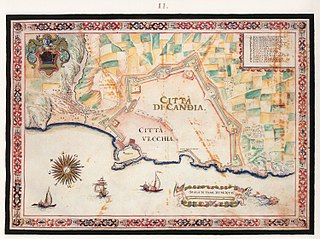
The Cretan War, also known as the War of Candia or the Fifth Ottoman–Venetian War, was a conflict between the Republic of Venice and her allies against the Ottoman Empire and the Barbary States, because it was largely fought over the island of Crete, Venice's largest and richest overseas possession. The war lasted from 1645 to 1669 and was fought in Crete, especially in the city of Candia, and in numerous naval engagements and raids around the Aegean Sea, with Dalmatia providing a secondary theater of operations.

The Fourth Ottoman–Venetian War, also known as the War of Cyprus was fought between 1570 and 1573. It was waged between the Ottoman Empire and the Republic of Venice, the latter joined by the Holy League, a coalition of Christian states formed by the pope which included Spain, the Republic of Genoa, the Duchy of Savoy, the Knights Hospitaller, and the Grand Duchy of Tuscany.

The Battle of Settepozzi was fought in the first half of 1263 off the Greek island of Settepozzi between a Genoese–Byzantine fleet and a smaller Venetian fleet.
The Venetian army was the army of the city-state of Venice, and later of the Republic of Venice and its dominions. During the Republic's early centuries, it was a force comprising an urban militia.

The Venetian navy was the navy of the Venetian Republic which played an important role in the history of the republic and the Mediterranean world. It was the premier navy in the Mediterranean Sea for many centuries between the medieval and early modern periods, providing Venice with control and influence over trade and politics far in excess of the republic's size and population. It was one of the first navies to mount gunpowder weapons aboard ships, and through an organised system of naval dockyards, armouries and chandlers was able to continually keep ships at sea and rapidly replace losses. The Venetian Arsenal was one of the greatest concentrations of industrial capacity prior to the Industrial Revolution and responsible for the bulk of the republic's naval power.
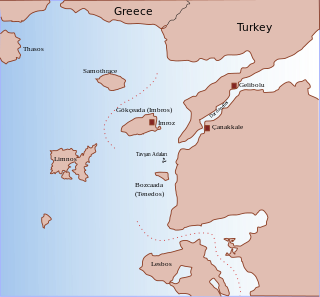
The Battle of Gallipoli occurred on 29 May 1416 between the fleets of the Republic of Venice and the Ottoman Empire off the port city of Gallipoli, the main Ottoman naval base. The battle was the main episode of a brief conflict between the two powers, resulting from Ottoman attacks against possessions and shipping of the Venetians and their allies in the Aegean Sea in 1414–1415. The Venetian fleet, under Pietro Loredan, was charged with transporting a Venetian embassy to the Ottoman sultan, but was authorized to attack if the Ottomans refused to negotiate. The subsequent events are known chiefly from a detailed letter written by Loredan after the battle.
Andrea Barozzi was a Venetian nobleman. He served as official and military commander for the Venetian Republic.
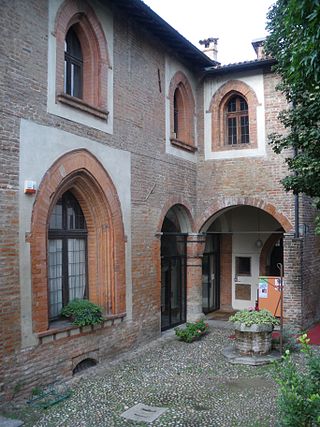
The Casa degli Eustachi is a medieval palace in Pavia in Lombardy.